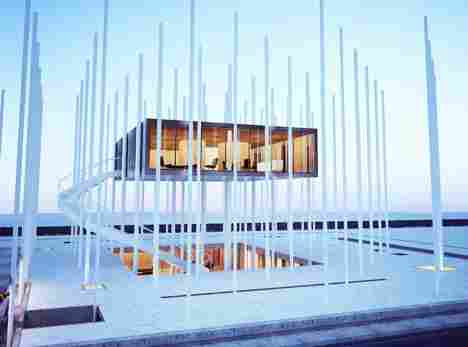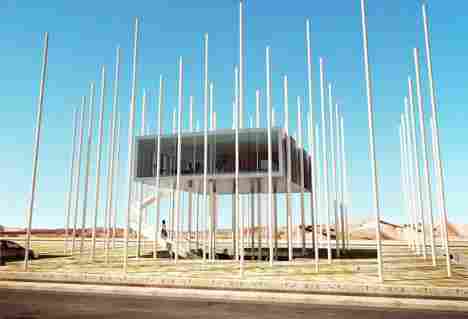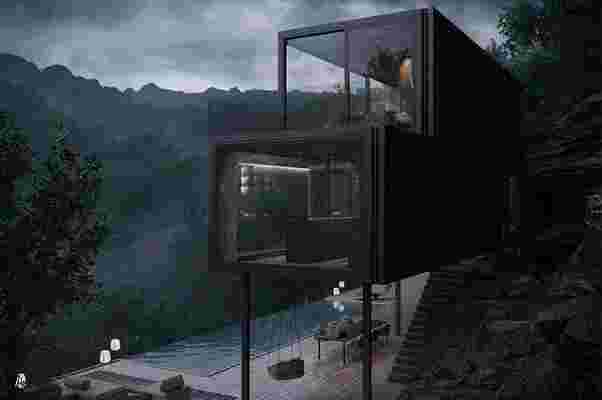
There’s something about the color black that is simply so mysterious and powerful. Most often people associate black with having a negative connotation, but there is definitely an undeniable allure to this strong color. When used correctly and tastefully in architecture , black can radiate a very modern and minimal feel, creating an aesthetic that instantly leaves you feeling calm and balanced. And this is exactly what this collection of all-black cabins do! Vacationing in a black-colored cabin may sound gloomy to you, but once you see the sheer beauty of such an architectural structure, it’ll be hard for you to say no! From a jet-black cabin with razor-sharp angles that’ll give you 007 feels, to a daredevil all-black hideaway cabin held by five support cables – this collection of all-black cabin designs is proof that when used boldly but smartly, black aesthetics can be a delight to holiday in!
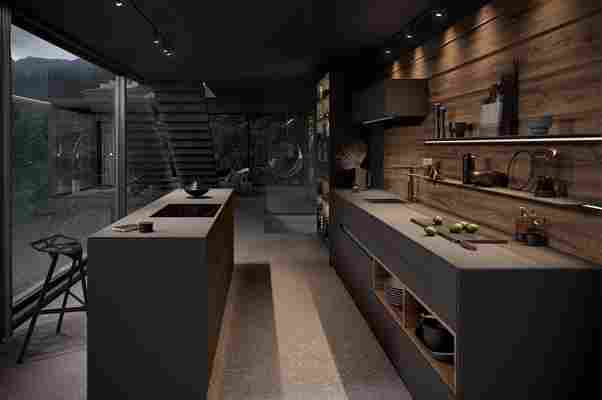
The Bali House from CASA Studio is a cantilevered multi-level mountain retreat with fully glazed glass windows for an almost-all-glass exterior, open-air terraces that offer unobstructed views, and sophisticated living areas with dark stone and warm wooden elements. Using 3dsmax, Corona Renderer, and Adobe Photoshop, interior photography, and CGI studio, CASA creates 3D visualizations of architectural plans and their interiors for clients in advertising and PR. Designing the escapist homes of our dreams is their job at Casa, and their latest called Bali House features an almost entirely glass facade and a cantilevered frame. Lodged into the mountainside, the Bali House keeps an obscure profile, with a jet black finish and unadorned exterior. On the property’s wood-slatted ground level, an infinity pool takes center stage beside a lounge and roofed dining area.
Suspended House is a reinterpreted A-frame cabin that hangs off a California cliffside with the help of five high-tensile support cables. Peeking out from the cliffs of Mendocino, California, Suspended House hovers in midair. In his rendering, Eshtiyaghi conceptualized Suspended House after choosing its cliffside location. To ensure that the structure would hold tight and remain in place, Eshtiyaghi looked to using five high-tensile support cables and a large foundation mast. The large mast works by balancing the forces of gravity and gently ‘tugging’ the A-frame cabin towards the mast for it to remain upright. In addition to the large foundation mast, five high-tensile support cables securely lodge the cabin in place from all sides.
Marc Thorpe, architect, and designer extraordinaire, recently unveiled his design for Canton House , a cluster of off-grid cabin hotels in the forest of Romania’s Carpathian Mountains that are built from locally harvested timber and inspired by the surrounding area’s vernacular architecture. In Romania, rural towers and spires of religious centers are often defined by their fully-shingled wooden construction. Inspired by the local area’s shingled roofs and facades, Thorpe clad Canton House’s trio of cabins, from top to bottom in blackened, locally sourced timber, wrapping the exterior facades in uniform wooden shingles. The triangular roof stems from Canton House’s rectangular front facade.
Studio Puisto, a sustainable interior design studio based in Finland, recently debuted the first prototype of cabins soon to be part of a larger hospitality project called Kivijärvi Resort. The resort’s first completed cabin is called Niliaitta , which refers to the traditional storage structure built at the end of a high pillar, used by the Sámi people to store food and equipment, keeping it safe from the grasp of hungry or curious wildlife. In order to immerse guests of Kivijärvi Resort in the elements of nature as safely, but also as close as possible, Studio Puisto installed a floor-to-ceiling window that stands some distance from the cabin’s deep gable roof. From Niliaitta’s front-facing window, guests enjoy the most dominant landscapes as the cabin’s location was purposefully selected to offer the most unobstructed views of Finland’s forest and nearby body of water.
Designed by Marc Thorpe , Edifice is a simple black off-grid cabin in Upstate New York. It’s been neatly tucked into the Catskill Mountains, situated in the little village of Fremont. The cabin features a single bedroom and occupies a total of 500 square meters. It’s nestled amongst trees, creating a quaint and quiet spot, that functions as a wonderful retreat in the midst of nature. The cabin was built as an example of “introverted architecture”, and is a self-sustaining structure that was an “exercise in reduction”. The little box is clad in stained cedar and features a simple rectangular form. The walls on the southern and western sides have thin windows, providing views of the surrounding greenery.
Blackbird is a getaway cabin that exists as “a place to be by oneself.” The getaway cabin, an angular structure of black mass combined with tinted glass and a jagged, haphazard display of metal beams, resembles a spaceship that can land in any environment. As conceptualized, Blackbird has landed in a Georgian forest clearing, amidst dense fog and textured pine trees, where it appears right at home. From the outside, below a white, cloudy sky, Blackbird’s asymmetrical frame has a tough exterior constructed from metal to provide a sense of security. Meant to dissolve the barrier between nature and the interior, the tinted glass windows evoke a feeling of privacy, like a lookout that allows its residents to remain hidden while scanning their surroundings.
On the island of Stokkøya, Norway lies a blackwood hill cabin . Surrounded by the sea to the west, and lush green landscapes to the east, it is a summer haven for a family of five. Expanding over several levels, the wooden cabin provides impressive views of its surroundings and is artfully balanced with them. The Kappland Arkitekter firm designed the cabin to ensure it perfectly merges with its surrounding landscape. Showcasing a typically Nordish minimal aesthetic, the cabin instantly washes you over with a sense of calm. “Perched on piles at the front and anchored on a concrete slab at the back, the building gently hovers on the slope, leaving hardly any footprint,” said the architecture studio. The leveled structure of the building creates several layers within the interiors of the cabin as well. According to the studio, one can experience the slopes of the hill within the house, and outside the house.
Birdbox is actually a prefabricated shipping container-like cabin that offers one-of-a-kind escapes to lush destinations surrounded by nature. The cabins are simple, rectangular structures with huge circular and oval windows to give you a larger-than-life view of nature. Just like the exterior, the interior also has minimal decor which makes for a cozy space with a queen bed and a handful of chairs. The Birdboxes come in two sizes currently – the “Mini” at 10.5’ x 7.2’ x 7.2’ “Mini” and the “Medi” at 16.7’ x 7.87’ x 7.87’.” There’s also a separate “Birdbox Bathroom” which features a black tint one-way glass floor-to-ceiling window.
The Livit Studypod is a futuristic black-box style cube that you can place anywhere you want and focus on your work, study or even health! This composite cube structure works as your bedroom, home office, or study table and is designed for outdoor use. Easy to place in your backyard, garden, or anywhere with a view, the black-tinted hardened glass window gives an unobstructed view of your scenery. Since the cube is a closed structure, it keeps you safe from the weather across the year. Measuring 2.15 x 1.8 x 2.1 meters, this cube is perfectly sized for you to style it for your comfort, improving your headspace, and keeping you stress-free. The pod does weigh 700 kilos but it also comes with optional wheels that let you move it and settle down for a quick change of scenery! The pod has oak flooring, a detachable desk, a power outlet, four downlights, and natural ventilation to keep the place airy.
Set on a rugged, 8-acre site on the secluded side of the island, the cabin offers magical views of the lush, lichen-covered rainforest and the serene bay water that surrounds it. The island is secluded from the dense population of Canadian cities but recent developments on and around it have left the natural sanctuary vulnerable. The Office of McFarlane Biggar Architects + Designers (OMB) has created an environmentally friendly alternative with a small environmental footprint to encourage sustainable travel and construction. “The views and access to sunshine were really the key considerations that helped us position the home,” says the architect. The cabin’s position is perpendicular to the rocky coastline and captures the sun from east to west, while the stained black cedar cladding helps it visually recede into the forest.
8 Magnificent Architecture and Urban-Space Designs from the iF Design Award global community
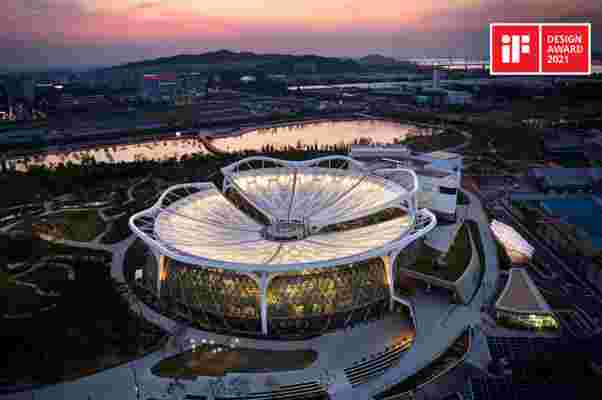
The iF Design Award has been consistently hand-picking the best, most innovative designs since 1953, honoring top-class achievements in categories spanning Product Design, Transportation Design, Communication Design, Packaging, Service Design, Architecture, Interior Architecture, Professional Concepts, and UI and UX for 67 years in a row. The entire iF Design Award program saw as many as 10,000 submissions this year, which were evaluated by 98 international design experts from 21 countries, on the iF Jury.
Just this year alone, 1,744 designs received the iF Design Award for their creative accomplishments across various categories, while an additional 75 designs went on to win the highly-coveted iF gold award for their outstanding work. The iF Design Award always culminates in a grand ceremony in Berlin, although owing to the pandemic and global travel restrictions, award-winning products and projects this year are being celebrated digitally with an international content campaign encapsulated by the slogan “The Creat iF e Power of Design” in cooperation with popular design platforms and seven renowned design museums.
Over the course of the next few months, Yanko Design will be curating and featuring winning designs from this year’s program too – we’ve hand-picked eight award-winning designs from the ‘Architecture and Urban Spaces’ category below (the list even features TWO iF Gold Award winners)! All the iF Design Award winners can also be viewed on the newly-launched iF Design App that gives you access to a grand database of award-winning design projects and their creators, right at your fingertips!
To view all these designs and many more, visit the website of the iF DESIGN AWARD .
Click Here to download the brand new iF Design App – a new experience in discovering outstanding designs
Award-Winning Architecture and Urban-Space Designs from the iF Design Award 2021
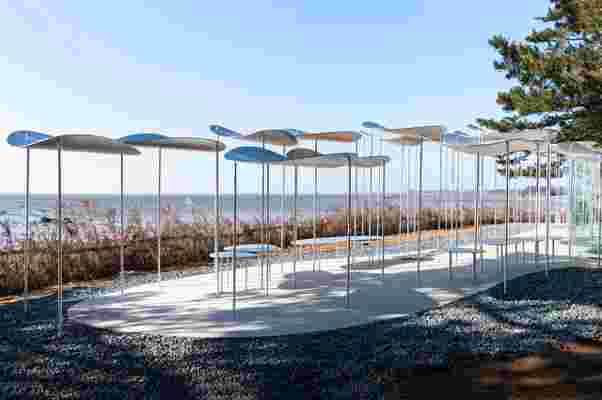
OSOL Art Pavilion by SOAP Design Studio for Gyeonggi Cultural Foundation (iF Gold Award Winner)
The OSOL Pavilion is a symbol of renewed beginnings and of friendship, as it stands at a place that was once littered with military fences. Built on the west coast of South Korea, the permanent exhibit marks the relaxing of military tension between North and South Korea, and sits among a forest of pine-trees facing the tranquil Yellow Sea. Inspired by the reflection of light on the sea, OSOL, the pine forest-like structure made from anodized aluminum, reflects the surrounding colors and allows visitors to gain a new perspective on the relationship between man and nature, encouraging them to develop a deeper appreciation of nature.
Traits Video Sketching App by Wolf In Motion (iF Gold Award Winner)
A sketching app with a difference, Traits lets you build architectural plans directly by drawing on videos. Paired along with drone footage, it’s the ultimate architecture and urban planning tool, providing a simple and inclusive way to plan out buildings without being too intrusive and requiring expensive filming crews and design-visualization teams. The app performs complex object tracking and lets you draw literally in a point in space, allowing you to easily make architectural plans and sketches directly onto video footage of the land, for quicker decision-taking.
Seoul Botanic Park by Samoo Architects & Engineers, and THE_SYSTEM LAB
Seoul Botanic Park was built in Magok, on the southwestern side of the Han River in Seoul, to create an urban public space that can introduce flora and cultures of 12 global cities and enhance ecological sensitivity. While most greenhouses come with a geodesic dome-shaped design, the Seoul Botanic Park flips this notion with its uniquely recognizable 100m wide concave roof. The rim of the greenhouse is higher than its center, giving it the resemblance of a flower – a feature that’s further highlighted by the petal-shaped pillars around the outer edge of the park.
The Future Of Us Pavilion by Thomas Schroepfer – Advanced Architecture Laboratory SUTD
The inspiration for The Future Of Us Pavilion was the visually beautiful experience of walking under the foliage of lush trees in the tropics. This idea was translated into a design with a clear mathematical logic that was determined by extensive environmental simulations and structural optimizations, resulting in an artificial canopy that still felt natural as you walked underneath it. Light filtered through the canopy’s perforated design – a phenomenon the Japanese call Komorebi – and as the canopy cut out a major chunk of sunlight, the area underneath was naturally cooled by the shade. Located in Gardens by the Bay Singapore, The Future Of Us Pavilion (also known as the Bayfront Pavilion) follows the tradition of architectural structures that evoke a dialogue with nature by blending an intricate form made of a perforated skin fluidly with the adjacent environments. For visitors, the building offers a climatically comfortable outdoor environment and a visual experience akin to walking under the foliage of lush tropical trees.
A House by Clearspace Design & Research
Adopting the rather traditional-looking A-Frame format, the simply named ‘A House’ is a combination of old but new and technical but naturally green. The building’s brick exterior is punctuated by transparent glass ‘curtains’ that not only give the exterior a uniquely memorable look, but even help illuminate the house’s interiors too. Although it’s titled ‘A House’, the building actually serves as a workplace, offering a close relationship between people and the natural environment. The designers also mention that it was refurbished following the 3Rs: Reduce, Reuse, and Recycle.
Cloister of Green Light by CYS.ADSO for Newland Developers Group
At this sales center, visitors can quietly experience the environment with their own senses instead of through text or speech. The amoeba-shaped building weaves through trees, coexisting with the flora without influencing or disturbing it. In order to achieve this, the designers thought of breaking the singular building mass into smaller scattered building units. These units are arranged randomly like satellites around the original trees, connected by the winding cloister and encircling the old tree at the center of the site.
V-Plaza by 3deluxe architecture for SBA Group
Yet another example of organic architectural design, the V-Plaza is a visionary plaza that is a celebration of contemporary mobility. Cyclists and scooters cruise along organically curved levels, between them oases of tranquility, water features, cafes, and restaurants. This hybrid of a skatepark, playground, and urban living room provides the perfect congregating point for the young, dynamic public of Lithuania.
DISC (Descente Innovation Studio Complex) by cre-te
Designed to be a sports R&D lab, the circular shape of the building is a reference to the circular tracks that runners dash around. It’s also characterized by an artificial hill in the form of a spiraling lawn that surrounds the building, creating a rather unusual blend of greenery and architecture. “Through this winding artificial hill, DISC achieves harmony with the urban context while maintaining an eco-friendly design”, mention the designers. The building’s design draws the viewers’ eyes to its center, which exists almost like a crater. Within this center is the building’s courtyard, its green heart, an open space for creative communication.
To view all these designs and many more, visit the website of the iF DESIGN AWARD .
Living Underground in Style
Plot #35 of the Ordos Project is not your typical villa. You won’t find it in Spain, France, or Italy. This one is in Inner Mongolia. The flat landscape is known for some of the most amazing blue skies on Earth but living there is harsh with high winds and extreme temperature grades.
Architect Juan Pablo Maza created a large underground home to take advantage of the ground’s natural insulation but the most striking feature is the suspended living area above ground surrounded by a forest of beams. A single stairway twists its way up making even the Apple Cube store in NYC seem complacent. Absolutely gorgeous.
Designer: Juan Pablo Maza via Arch Daily
